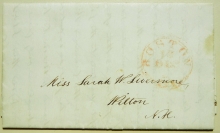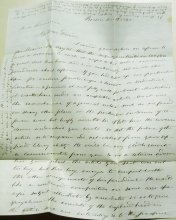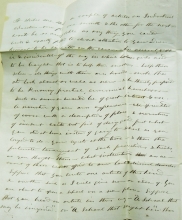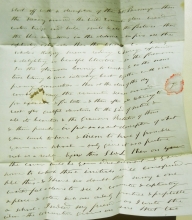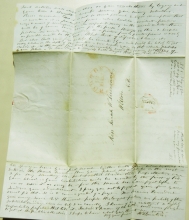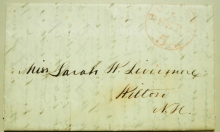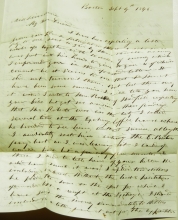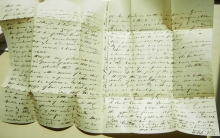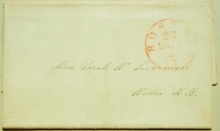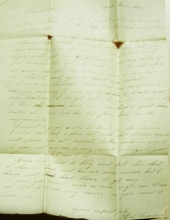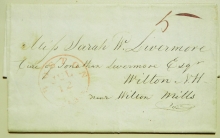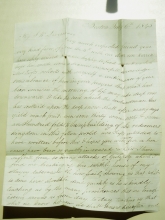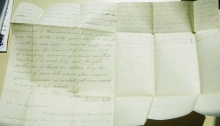Year:
Four letters to Sarah W. Livermore, renowned women’s advocate, poet, illustrator and founder of a private boarding school in her home in Wilton, New Hampshire. Ms. Livermore illustrated many of her poems. Her works currently sell for thousands of dollars in finer auctions. One letter is dated July 6, 1845. One letter is undated but the postmark puts it in the area of 1846. Two letters are dated September 4 and December 18, 1846.
From: “Singers of Songs of the Liberal Faith” 1874 -- SARAH W. LIVERMORE. (1789-1874) Sarah White Livermore was born in Wilton, N.H., July 20, 1789, and was the daughter of Rev. Jonathan Livermore, who was settled as the first minister of that town, Dec. 14, 1763. Having faithfully improved the limited advantages of her early life, she became, while still young, a very successful teacher of common schools. About the year 1843, she established a self-supporting boarding-school at the Livermore Mansion in Wilton. After a few years, however, she was obliged to relinquish the care of it on account of ill-health. Her interest in the welfare of children manifested itself in efforts for their religious as well as their secular instruction. She was greatly instrumental in establishing, in her native town, one of the first Sunday-schools in the country. It was in successful operation as long ago as 1816,—the year when, as we are told by Mr. Lewis G. Pray, in his "History of Sunday-Schools," these institutions began to take the form of a voluntary and improved system.
Miss Livermore, having a natural talent and taste for poetic composition, was often called upon, during her long life, to write verses for a great variety of occasions. These have never been collected and published, though not a few of them have been printed for use in connection with ordination or dedicatory services, or commemorative or festive celebrations. She died in Wilton, July 3, 1874, having nearly completed her eighty-fifth year. Of the four hymns which we copy, the first two are, one or both, in several of our Collections, and are here taken from the book of "Christian Hymns," compiled by a committee of the Cheshire Pastoral Association. The other two are not so well known.
History of the Town of Wilton, Hillsborough County, New Hampshire 1888
Miss Sarah W. Livermore, also, with Miss Abigail Kimball as assistant, kept a private boarding and day school at her own house for a number of years for pupils of both sexes from abroad and in town.
The December letter is from a friend, W. Burton and is very interesting. Livermore has sent him an article advancing the cause of the industrial education of women and reform in regards to female wages and taxation. (Yes, the same topic still prevalent today!!!) Burton writes that he has shown the article to a publisher…Mr. Brown…who “thought that the subject was treated in too general a manner to make it useful to his readers.” Burton says Brown “will be very glad to insert a commendation from you and as a return advertise your school.” Apparently the article contained several anecdotes and Burton suggests she limit the number used. He suggests breaking what must have been a prolific article into a couple of articles on industrial education and that these would also direct attention to her advertisement. The advice continues suggesting she write about “the way in which ladies (crossed out) girls used to be brought [up] – that is to help their mothers – help themselves – do things with their own hands – make the old look almost as well as new -- & be thereby be prepared to be knowing, practical, economical housekeepers.” A few lines later he refers to the women as “lackadaisical damsels. (Most likely not what Livermore had in mind!)
Burton continues: “Suppose that you write one article of this kind & another such as I will give now an idea of. You are about to open a school on a new plan. Suppose that you head on article in this way – “A School that may be imagined” or “A School that might be”.
It is a long letter with much more along the same theme. Tiny breaks at the intersection folds and the usual tear at the seal location.
The September letter talks of Burton’s efforts to collect a bill due from Mr. and Mrs. Roberts of Medford. Burton had no success at the house, or at the Exchange Coffee house where Roberts was supposed to be. He finally ran into him by accident entering the East Boston ferry boat. The letter mentions that Burton’s sister is “in pursuit of schools”; talks about his home in East Boston and says he is talking with others about going to Wilton to lecture, including Fowler the Thermologist. A more general missive than the December letter, but still interesting. Pinhole breaks at the intersections and very small tear at the seal.
The undated letter is from E. A. Simpson, who was a student at the Livermore school. She writes that she has returned safely home to Boston. She writes that her mother had previously sent a letter containing $80 to her and when it arrives, Ms. Livermore should open it and take out her tuition and board. Apparently there will be some left over which the writer asks her to keep as a present. She also writes that her aunt had wanted to attend the school, but, upon arrival home, the writer found out that the aunt had died. “She was very sick and there has been a great many deaths. They have had the ship fever here in the neighborhood.” She sends her love to Abby and that she will send her some music, but hasn’t had the time. She plans to work in a store after caring for her mother. One-page letter from appreciative student. Separations at the folds and typical small hole where seal was broken.
The July 6, 1845 letter is from Gardner Tufts (see information below) writing clearly and eloquently: “Very much respected friend your very kind favor of June the 4th with our dear son Warren have safely arrived & we are happy to find as you & we both hope has made some advances in usefull knowledge. Mrs. Tufts solicits with myself a continuance of your remembrance of him in your prayers that what has been sown in the morning of life may take deep root downward & like the seed which the husbandman has scattered upon the deep snow shall after many days yield much fruit even some thirty some sixty & some hundred fold to the upbuilding of the redeemers kingdom in this fallen world. Mrs. Tufts intended to have written before this & hopes you will excuse her as her cares have been so greatly increased whilst I have suffered from so many attacks of epilepsy which I find are breaking up this earthly house of my tabernacle. Oh how frail, showing us that what is done here should be done quickly as he is kindly teaching us by the many provinces that are transpiring around us from day to day teaching us that what we know not now we shall know hereafter…” Tufts says he has not heard anything about Livermore’s brother and hopes he is getting better and also declines her invitation for a summer visit to New Hampshire. He invites her to visit them should she be in Boston. Also, he enclosed $30 as the balance of Warren’s school bill (not included in lot). Mrs. Tufts adds that her son was pleased with the letter Livermore provided to him and sends her sincere thanks as well. This is an excellent addition to this group. Letter is in quite good condition with no tear where seal was located.
The Boston directory for the year 1832 includes an advertisement for Gardner Tufts listing him as a “collector of bills, notes and subscriptions for physicians, corporations and societies. Also rents of tenants, and bills and notes for individuals. For the faithful discharge of which, satisfactory reference can be given when required Orders left at E. & J. Vose’s hatters, 86 Washington Street or at No 58n Essex Street will be promptly attended to.”

